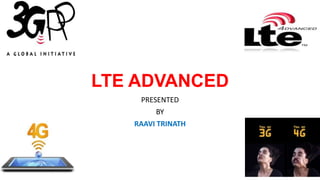
LTE ADVANCED PPT
- 2. INTRODUCTION • LTE Advanced is a mobile communication standard, formally submitted as a candidate 4G system to ITU-T in late 2009. • It was approved into ITU,IMT-Advanced and was finalized by 3GPP in March 2011. • Standardized by the 3GPP as a major enhancement of the LTE standard. • It was commercially implemented in October 2012 by Russian network Yota.
- 3. Key milestones for ITU-R IMT Advanced evaluation MILESTONE DATE Issue invitation to propose Radio Interface Technologies. March 2008 ITU date for cut-off for submission of proposed Radio Interface Technologies. October 2009 Cutoff date for evaluation report to ITU. June 2010 Decision on framework of key characteristics of IMT Advanced Radio Interface Technologies. October 2010 Completion of development of radio interface specification recommendations. February 2011
- 4. LTE-Advanced Development History WCDMA (UMTS) HSPA HSDPA / HSUPA HSPA+ LTE LTE ADVANCED (IMT ADVANCED) Max downlink speed (bps) 384k 14 M 28 M 100 M 1 G Max uplink speed (bps) 128 k 5.7 M 11 M 50 M 500 M Latency round trip time (approx.) 150 ms 100 ms 50 ms (max) ~10 ms Less than 5 ms 3GPP releases Rel 99/4 Rel 5/6 Rel 7 Rel 8/9 Rel 10 Approx years of initial roll out 2003/4 2005/6 HSDPA 2007/8 HSUPA 2008/9 2009/10 Access methodology CDMA CDMA CDMA OFDMA/SC-FDMA OFDMA/SC-FDMA
- 5. LTE Advanced Key Features • Peak data rates: downlink - 1 Gbps; uplink - 500 Mbps. • Spectrum efficiency: 3 times greater than LTE. • Peak spectrum efficiency: downlink - 30 bps/Hz; uplink - 15 bps/Hz. • Spectrum use: the ability to support scalable bandwidth use and spectrum aggregation where non-contiguous spectrum needs to be used. • Latency: from Idle to Connected in less than 50 ms and then shorter than 5 ms one way for individual packet transmission.
- 6. • Cell edge user throughput to be twice that of LTE. • Average user throughput to be 3 times that of LTE. • Mobility: Same as that in LTE • Compatibility: LTE Advanced shall be capable of interworking with LTE and 3GPP legacy systems.
- 7. Comparison between LTE & Advanced LTE
- 8. • Carrier Aggregation (CA). • Enhanced use of multi-antenna techniques. • Support for Relay Nodes (RN). The main new functionalities introduced in LTE-Advanced
- 9. Carrier Aggregation • Each aggregated carrier is referred to as a component carrier. • Use maximum of five component carriers. • Each of BW of 1.4Mhz, 3Mhz,5Mhz, 10Mhz, 15Mhz or 20 Mhz. • The individual component carriers can also be of different bandwidths.
- 10. • Channel BW per CCs can be different b/w UL & DL. • The individual component carriers can also be of different bandwidths.
- 11. Three Different Scenarios INTRA BAND, CONTIGUOUS INTRA BAND, NON CONTIGUOUS INTER BAND, NON CONTIGUOUS
- 12. o Intra Band, Contiguous The CCs are allocated within the same operating band and they are contiguous. o Intra Band, Non Contiguous The CCs are allocated within the same operating band and they are not contiguous.
- 13. o Inter Band, Non Contiguous • The CCs allocated in different operating bands. • The CCs will experience different pathloss, which increases with increasing frequency
- 14. MIMO, Multiple Input Multiple Output – or spatial multiplexing • Used to increase the overall bitrate • Through transmission of two (or more) different data streams on two (or more) different antennas • Using the same resources in both frequency and time, separated only through use of different reference signals • to be received by two or more antennas.
- 15. • A major change in LTE-Advanced is the introduction of higher order MIMO; 8x8 in the DL and 4x4 in the UL. • MIMO shall be used when S/N (Signal to Noise ratio) is high, i.e. high quality radio channel. • For situations with low S/N it is better to use other types of multi- antenna techniques to improve S/N, e.g. TX-diversity
- 16. Relay Nodes • The Relay Nodes are low power base stations • Provide enhanced coverage and capacity at cell edges • It can also be used to connect to remote areas without fibre connection.
- 17. • The Relay Node (RN) is connected to the DeNB via the radio interface Un. • UEs at the edge of the donor cell are connected to the RN via Uu, • UEs closer to the DeNB are directly connected to the DeNB via the Uu interface. • When the Uu and Un use different frequencies the Relay Node is referred to as a Type 1a RN. • For Type 1 RN , Uu and Un utilize the same frequencies. • There is a high risk for self interference in the Relay Node. • This can be avoided through time sharing between Uu and Un, • Or having different locations of the transmitter and receiver.